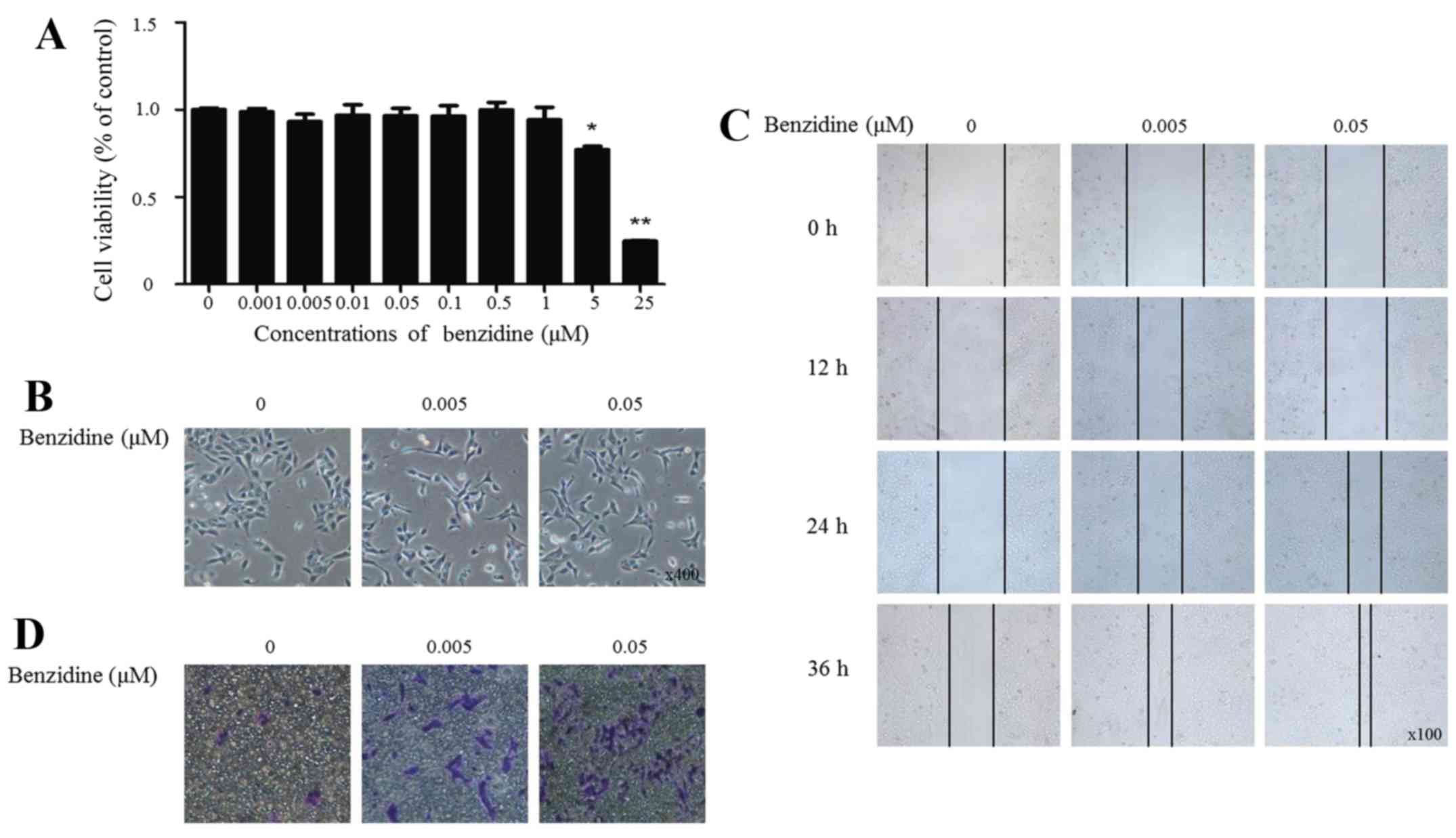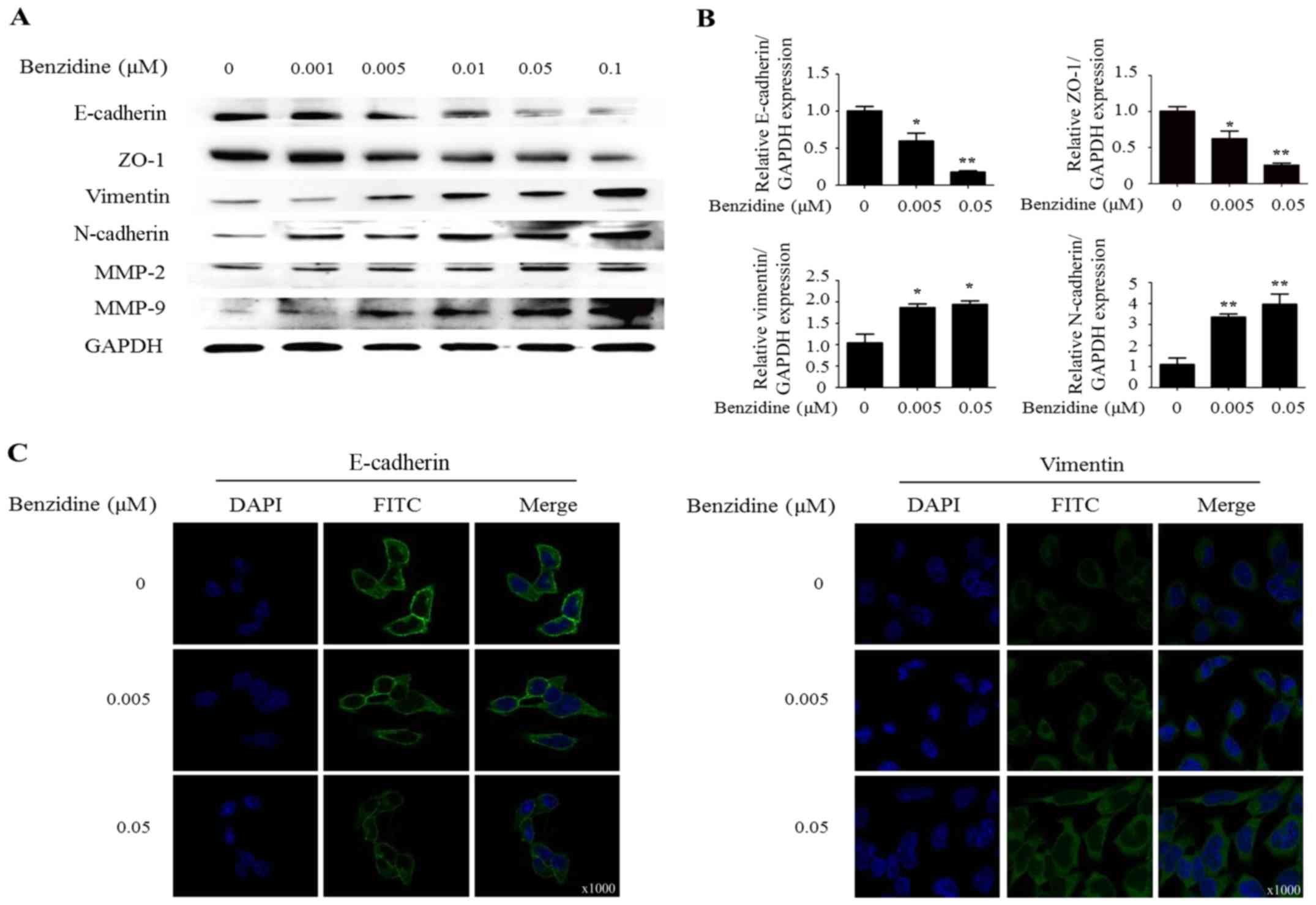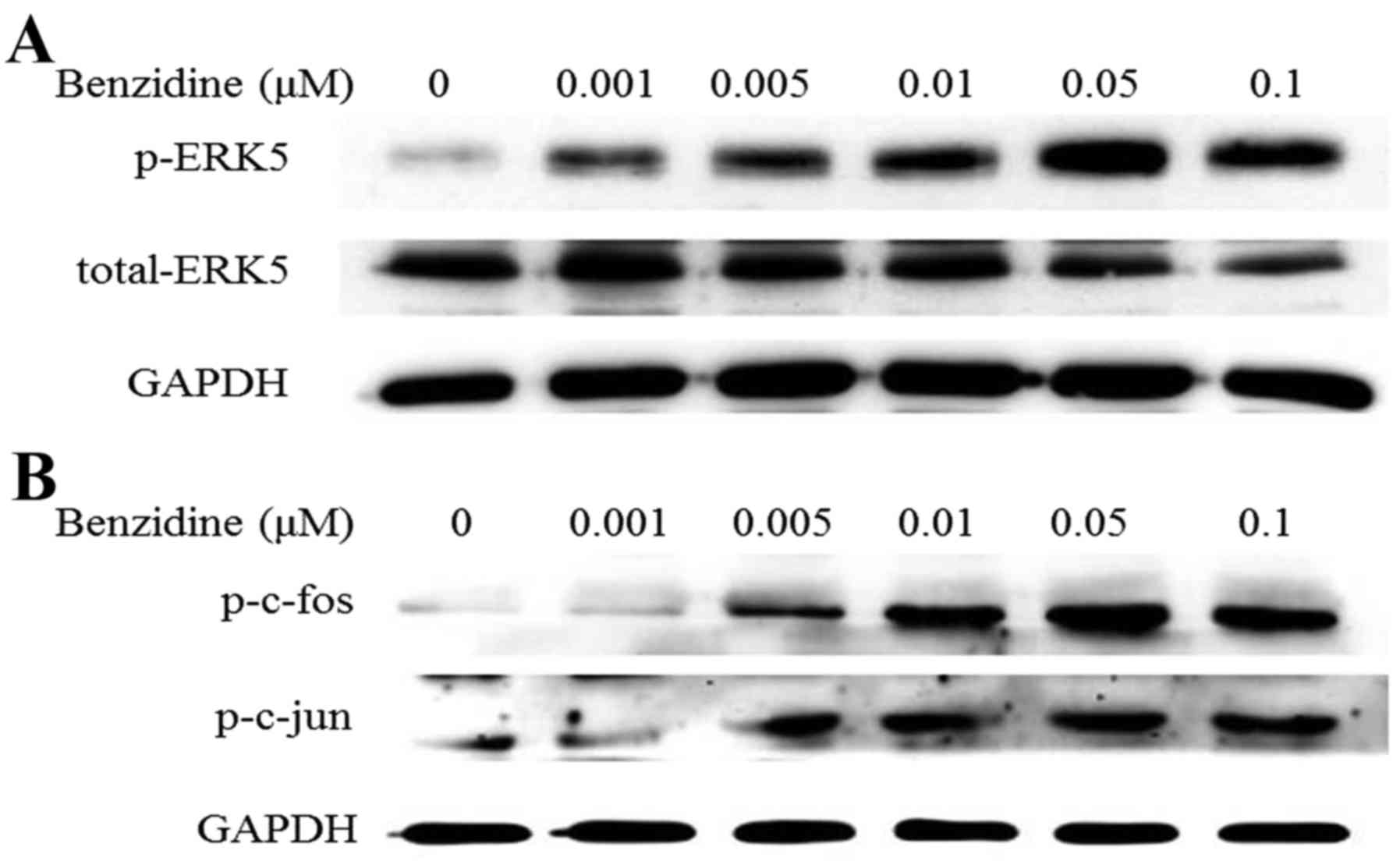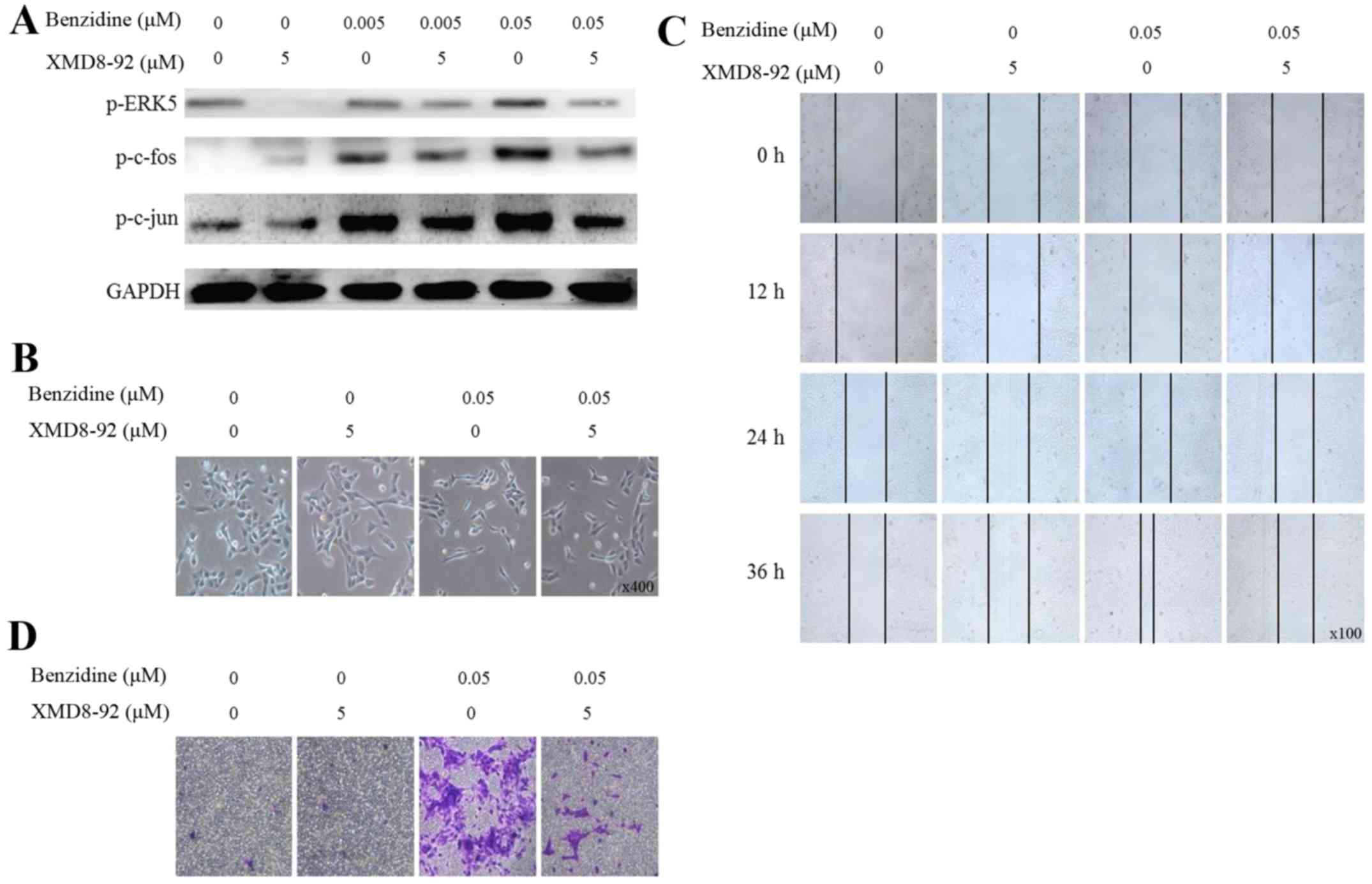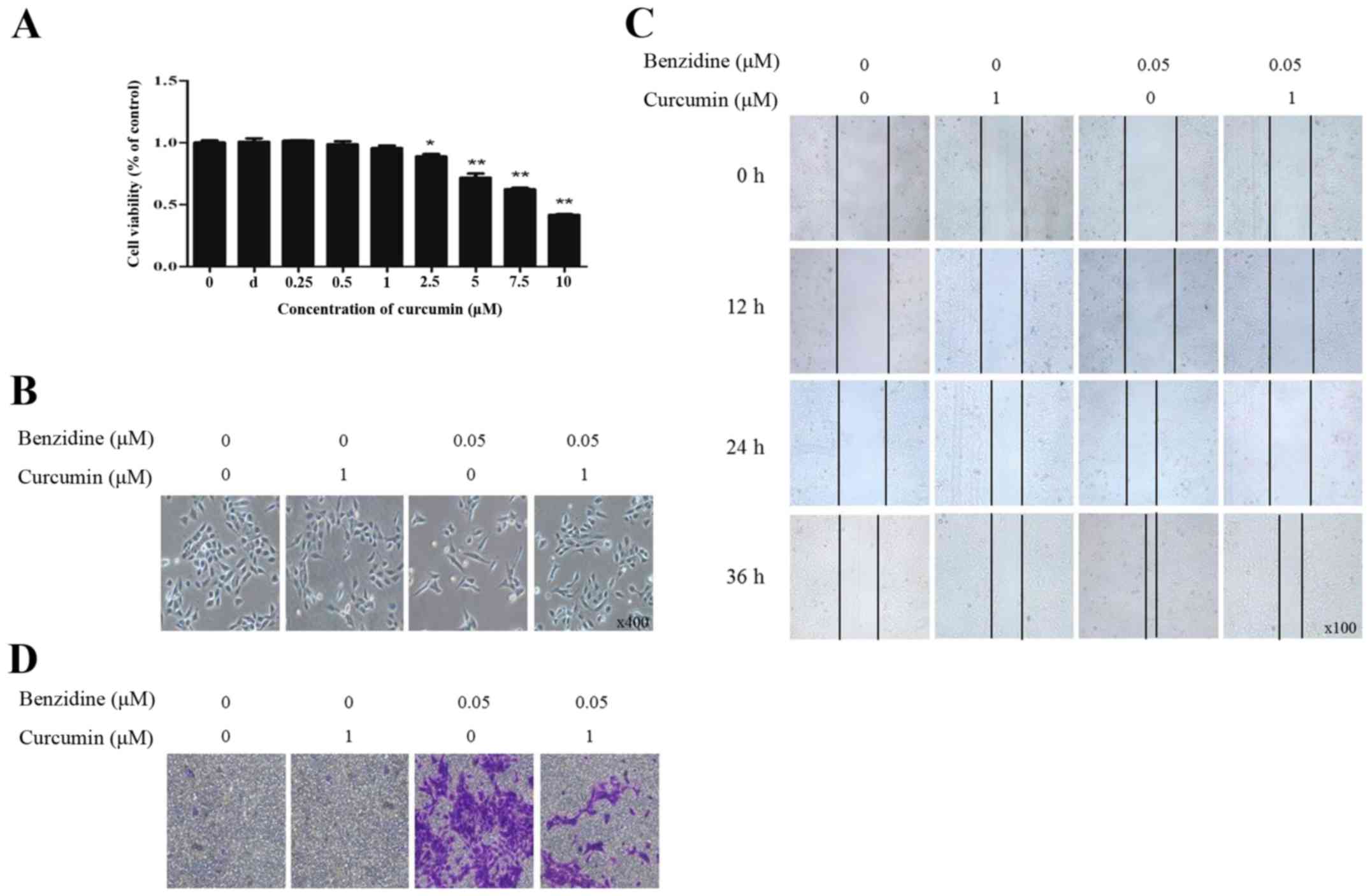|
1
|
Chen W, Zheng R, Baade PD, Zhang S, Zeng
H, Bray F, Jemal A, Yu XQ and He J: Cancer statistics in China,
2015. CA Cancer J Clin. 66:115–132. 2016. View Article : Google Scholar : PubMed/NCBI
|
|
2
|
Letašiová S, Medve'ová A, Šovčíková A,
Dusinská M, Volkovová K, Mosoiu C and Bartonová A: Bladder cancer,
a review of the environmental risk factors. Environ Health.
11(Suppl 1): S112012. View Article : Google Scholar
|
|
3
|
Choudhary G: Human health perspectives on
environmental exposure to benzidine: A review. Chemosphere.
32:267–291. 1996. View Article : Google Scholar : PubMed/NCBI
|
|
4
|
Whysner J, Verna L and Williams GM:
Benzidine mechanistic data and risk assessment: Species- and
organ-specific metabolic activation. Pharmacol Ther. 71:107–126.
1996. View Article : Google Scholar : PubMed/NCBI
|
|
5
|
Baan R, Grosse Y, Straif K, Secretan B, El
Ghissassi F, Bouvard V, Benbrahim-Tallaa L, Guha N, Freeman C,
Galichet L, et al WHO International Agency for Research on Cancer:
Monograph Working Group: A review of human carcinogens–Part F:
Chemical agents and related occupations. Lancet Oncol.
10:1143–1144. 2009. View Article : Google Scholar : PubMed/NCBI
|
|
6
|
Snyderwine EG, Sinha R, Felton JS and
Ferguson LR: Highlights of the eighth international conference on
carcinogenic/mutagenic N-substituted aryl compounds. Mutat Res.
506–507:1–8. 2002. View Article : Google Scholar
|
|
7
|
Yu MC, Skipper PL, Tannenbaum SR, Chan KK
and Ross RK: Arylamine exposures and bladder cancer risk. Mutat
Res. 506–507:21–28. 2002. View Article : Google Scholar
|
|
8
|
Chen HI, Liou SH, Loh CH, Uang SN, Yu YC
and Shih TS: Bladder cancer screening and monitoring of
4,4′-methylenebis(2-chloroaniline) exposure among workers in
Taiwan. Urology. 66:305–310. 2005. View Article : Google Scholar : PubMed/NCBI
|
|
9
|
Kalluri R: EMT: When epithelial cells
decide to become mesenchymal-like cells. J Clin Invest.
119:1417–1419. 2009. View
Article : Google Scholar : PubMed/NCBI
|
|
10
|
Li L and Li W: Epithelial-mesenchymal
transition in human cancer: Comprehensive reprogramming of
metabolism, epigenetics, and differentiation. Pharmacol Ther.
150:33–46. 2015. View Article : Google Scholar : PubMed/NCBI
|
|
11
|
Voulgari A and Pintzas A:
Epithelial-mesenchymal transition in cancer metastasis: Mechanisms,
markers and strategies to overcome drug resistance in the clinic.
Biochim Biophys Acta. 1796:75–90. 2009.PubMed/NCBI
|
|
12
|
Zhao L, Geng H, Liang ZF, Zhang ZQ, Zhang
T, Yu DX and Zhong CY: Benzidine induces epithelial-mesenchymal
transition in human uroepithelial cells through ERK1/2 pathway.
Biochem Biophys Res Commun. 459:643–649. 2015. View Article : Google Scholar : PubMed/NCBI
|
|
13
|
Chang L and Karin M: Mammalian MAP kinase
signalling cascades. Nature. 410:37–40. 2001. View Article : Google Scholar : PubMed/NCBI
|
|
14
|
Drew BA, Burow ME and Beckman BS:
MEK5/ERK5 pathway: The first fifteen years. Biochim Biophys Acta.
1825:37–48. 2012.
|
|
15
|
Nishimoto S and Nishida E: MAPK
signalling: ERK5 versus ERK1/2. EMBO Rep. 7:782–786. 2006.
View Article : Google Scholar : PubMed/NCBI
|
|
16
|
Hayashi M, Fearns C, Eliceiri B, Yang Y
and Lee JD: Big mitogen-activated protein kinase 1/extracellular
signal-regulated kinase 5 signaling pathway is essential for
tumor-associated angiogenesis. Cancer Res. 65:7699–7706.
2005.PubMed/NCBI
|
|
17
|
Amano S, Chang YT and Fukui Y: ERK5
activation is essential for osteoclast differentiation. PLoS One.
10:e01250542015. View Article : Google Scholar : PubMed/NCBI
|
|
18
|
Zhong CY, Zhou YM, Douglas GC, Witschi H
and Pinkerton KE: MAPK/AP-1 signal pathway in tobacco smoke-induced
cell proliferation and squamous metaplasia in the lungs of rats.
Carcinogenesis. 26:2187–2195. 2005. View Article : Google Scholar : PubMed/NCBI
|
|
19
|
Zhao J, Harper R, Barchowsky A and Di YPP:
Identification of multiple MAPK-mediated transcription factors
regulated by tobacco smoke in airway epithelial cells. Am J Physiol
Lung Cell Mol Physiol. 293:L480–L490. 2007. View Article : Google Scholar : PubMed/NCBI
|
|
20
|
Geng H, Zhao L, Liang Z, Zhang Z, Xie D,
Bi L, Wang Y, Zhang T, Cheng L, Yu D, et al: ERK5 positively
regulates cigarette smoke- induced urocystic epithelial-mesenchymal
transition in SV-40 immortalized human urothelial cells. Oncol Rep.
34:1581–1588. 2015.PubMed/NCBI
|
|
21
|
Park W, Amin ARMR, Chen ZG and Shin DM:
New perspectives of curcumin in cancer prevention. Cancer Prev Res
(Phila). 6:387–400. 2013. View Article : Google Scholar
|
|
22
|
Kawami M, Harabayashi R, Miyamoto M,
Harada R, Yumoto R and Takano M: Methotrexate-induced
epithelial-mesenchymal transition in the alveolar epithelial cell
line A549. Lung. 194:923–930. 2016. View Article : Google Scholar : PubMed/NCBI
|
|
23
|
Zhang P, Dong Z, Cai J, Zhang C, Shen Z,
Ke A, Gao D, Fan J and Shi G: BRD4 promotes tumor growth and
epithelialmesenchymal transition in hepatocellular carcinoma. Int J
Immunopathol Pharmacol. 28:36–44. 2015. View Article : Google Scholar : PubMed/NCBI
|
|
24
|
Peralta Soler A, Knudsen KA, Jaurand MC,
Johnson KR, Wheelock MJ, Klein-Szanto AJ and Salazar H: The
differential expression of N-cadherin and E-cadherin distinguishes
pleural mesotheliomas from lung adenocarcinomas. Hum Pathol.
26:1363–1369. 1995. View Article : Google Scholar : PubMed/NCBI
|
|
25
|
Nakajima S, Doi R, Toyoda E, Tsuji S, Wada
M, Koizumi M, Tulachan SS, Ito D, Kami K, Mori T, et al: N-cadherin
expression and epithelial-mesenchymal transition in pancreatic
carcinoma. Clin Cancer Res. 10:4125–4133. 2004. View Article : Google Scholar : PubMed/NCBI
|
|
26
|
Zhang X, Song Q, Wei C and Qu J: LRIG1
inhibits hypoxia- induced vasculogenic mimicry formation via
suppression of the EGFR/PI3K/AKT pathway and
epithelial-to-mesenchymal transition in human glioma SHG-44 cells.
Cell Stress Chaperones. 20:631–641. 2015. View Article : Google Scholar : PubMed/NCBI
|
|
27
|
Li J, Deng Z, Wang Z, Wang D, Zhang L, Su
Q, Lai Y, Li B, Luo Z, Chen X, et al: Zipper-interacting protein
kinase promotes epithelial-mesenchymal transition, invasion and
metastasis through AKT and NF-κB signaling and is associated with
metastasis and poor prognosis in gastric cancer patients.
Oncotarget. 6:8323–8338. 2015. View Article : Google Scholar : PubMed/NCBI
|
|
28
|
Park JH, Yoon J, Lee KY and Park B:
Effects of geniposide on hepatocytes undergoing
epithelial-mesenchymal transition in hepatic fibrosis by targeting
TGFβ/Smad and ERK-MAPK signaling pathways. Biochimie. 113:26–34.
2015. View Article : Google Scholar : PubMed/NCBI
|
|
29
|
Kasler HG, Victoria J, Duramad O and
Winoto A: ERK5 is a novel type of mitogen-activated protein kinase
containing a transcriptional activation domain. Mol Cell biol.
20:8382–8389. 2000. View Article : Google Scholar : PubMed/NCBI
|
|
30
|
Morimoto H, Kondoh K, Nishimoto S,
Terasawa K and Nishida E: Activation of a C-terminal
transcriptional activation domain of ERK5 by autophosphorylation. J
biol Chem. 282:35449–35456. 2007. View Article : Google Scholar : PubMed/NCBI
|
|
31
|
Nithianandarajah-Jones GN, Wilm B,
Goldring CE, Müller J and Cross MJ: ERK5: Structure, regulation and
function. Cell Signal. 24:2187–2196. 2012. View Article : Google Scholar : PubMed/NCBI
|
|
32
|
Sohn SJ, Li D, Lee LK and Winoto A:
Transcriptional regulation of tissue-specific genes by the ERK5
mitogen-activated protein kinase. Mol Cell Biol. 25:8553–8566.
2005. View Article : Google Scholar : PubMed/NCBI
|
|
33
|
Mulloy R, Salinas S, Philips A and
Hipskind RA: Activation of cyclin D1 expression by the ERK5
cascade. Oncogene. 22:5387–5398. 2003. View Article : Google Scholar : PubMed/NCBI
|
|
34
|
Pi X, Garin G, Xie L, Zheng Q, Wei H, Abe
J, Yan C and Berk BC: BMK1/ERK5 is a novel regulator of
angiogenesis by destabilizing hypoxia inducible factor 1alpha. Circ
Res. 96:1145–1151. 2005. View Article : Google Scholar : PubMed/NCBI
|
|
35
|
Bakiri L, Macho-Maschler S, Custic I,
Niemiec J, Guío- Carrión A, Hasenfuss SC, Eger A, Müller M, Beug H
and Wagner EF: Fra-1/AP-1 induces EMT in mammary epithelial cells
by modulating Zeb1/2 and TGFβ expression. Cell Death Differ.
22:336–350. 2015. View Article : Google Scholar
|
|
36
|
Qiao Y, Shiue CN, Zhu J, Zhuang T, Jonsson
P, Wright AP, Zhao C and Dahlman-Wright K: AP-1–mediated chromatin
looping regulates ZEB2 transcription: New insights into TNFα-
induced epithelial-mesenchymal transition in triple-negative breast
cancer. Oncotarget. 6:7804–7814. 2015. View Article : Google Scholar : PubMed/NCBI
|
|
37
|
Nam EH, Lee Y, Moon B, Lee JW and Kim S:
Twist1 and AP-1 cooperatively upregulate integrin α5 expression to
induce invasion and the epithelial-mesenchymal transition.
Carcinogenesis. 36:327–337. 2015. View Article : Google Scholar : PubMed/NCBI
|
|
38
|
Gao J, Yan Q, Wang J, Liu S and Yang X:
Epithelial-to- mesenchymal transition induced by TGF-β1 is mediated
by AP1–dependent EpCAM expression in MCF-7 cells. J Cell Physiol.
230:775–782. 2015. View Article : Google Scholar
|
|
39
|
Gupta SC, Patchva S and Aggarwal BB:
Therapeutic roles of curcumin: Lessons learned from clinical
trials. AAPS J. 15:195–218. 2013. View Article : Google Scholar :
|
|
40
|
Shanmugam MK, Rane G, Kanchi MM, Arfuso F,
Chinnathambi A, Zayed ME, Alharbi SA, Tan BK, Kumar AP and Sethi G:
The multifaceted role of curcumin in cancer prevention and
treatment. Molecules. 20:2728–2769. 2015. View Article : Google Scholar : PubMed/NCBI
|
|
41
|
Fetoni AR, Paciello F, Mezzogori D, Rolesi
R, Eramo SL, Paludetti G and Troiani D: Molecular targets for
anticancer redox chemotherapy and cisplatin-induced ototoxicity:
The role of curcumin on pSTAT3 and Nrf-2 signalling. Br J Cancer.
113:1434–1444. 2015. View Article : Google Scholar : PubMed/NCBI
|
|
42
|
Woo MS, Jung SH, Kim SY, Hyun JW, Ko KH,
Kim WK and Kim HS: Curcumin suppresses phorbol ester-induced matrix
metalloproteinase-9 expression by inhibiting the PKC to MAPK
signaling pathways in human astroglioma cells. Biochem Biophys Res
Commun. 335:1017–1025. 2005. View Article : Google Scholar : PubMed/NCBI
|



